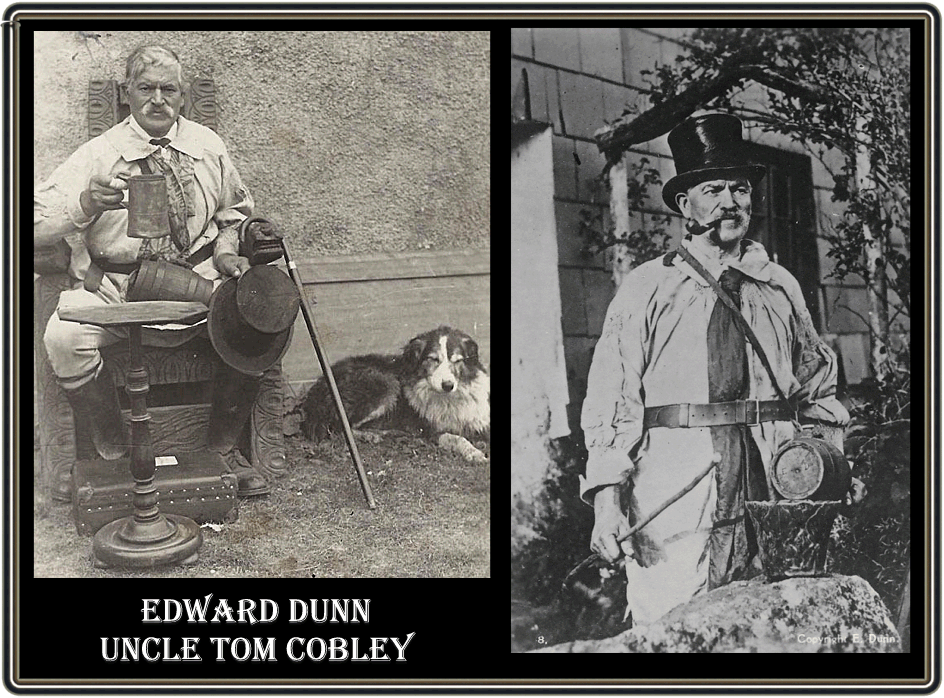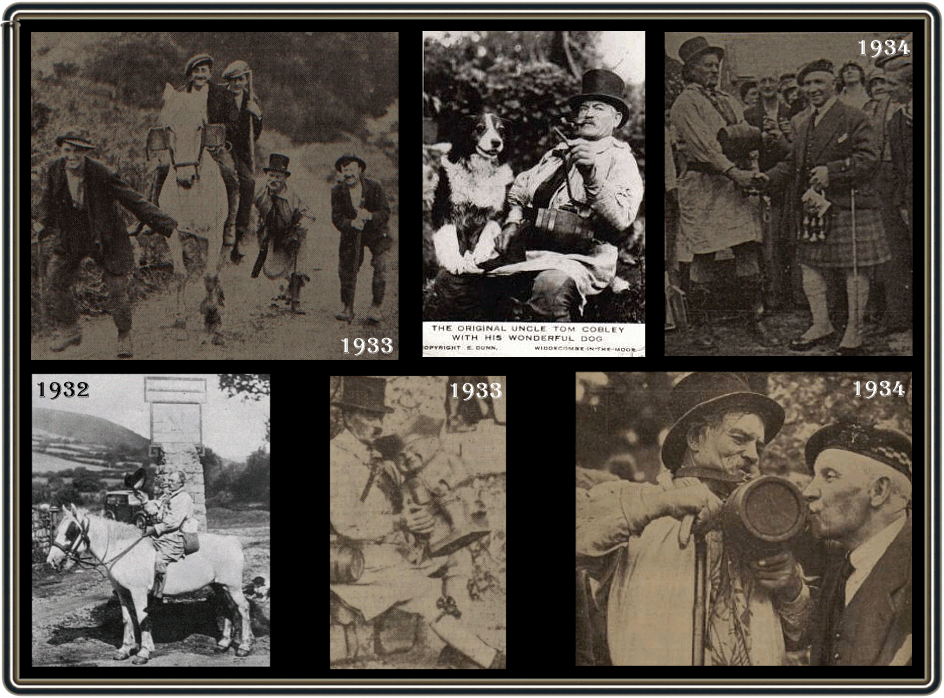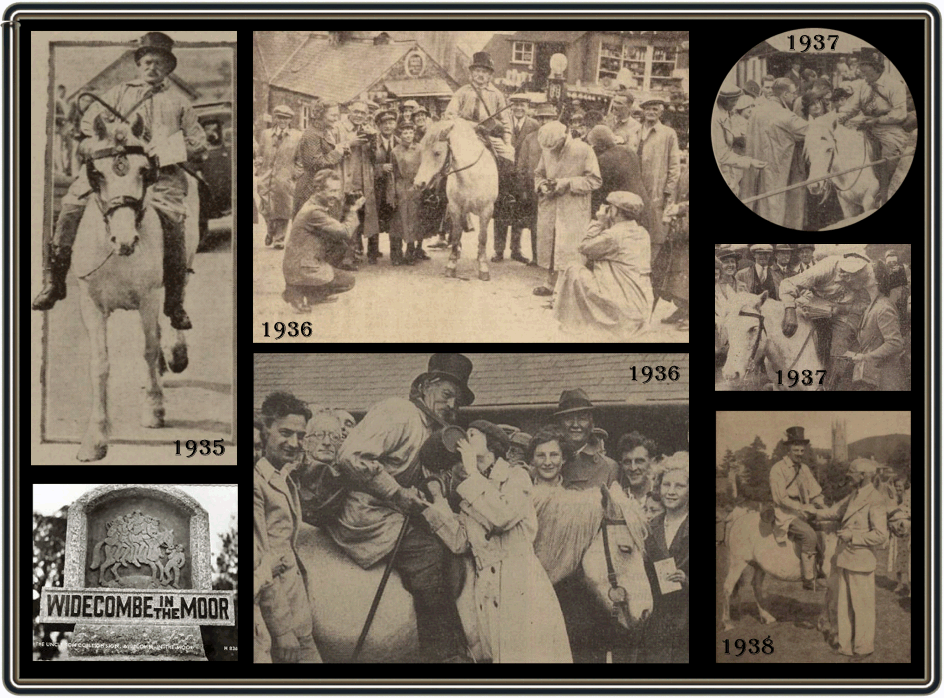
The first recorded evidence of Widecombe Fair appeared on Saturday, October the 19th 1850 when the Exeter and Plymouth Gazette announced that on the following Friday (25th) a Free Fair would be held on the Green which adjoined the churchyard at Widecombe-in-the-Moor. It was expected that a large show of cattle and moorland sheep would be offered for sale. The following Saturday the same paper reported that “A cattle fair was held at Widecombe-in-the-Moor for the first time on Tuesday last.
Some thirty or forty years later the world famous song – ‘Widecombe Fair‘ which featured the well-known character – Uncle Tom Cobley and his sidekicks became popular. The song was first published, either in 1880 by Mr W. Davies or in 1888 by Mr. W. F. Collier. However it was Sabine Baring Gould’s book – Songs of the West that brought it to fame when he published it in 1890.
The Widecombe fair held in 1928 was the first to make a solid connection with the Widecombe fair song, Uncle Tom Cobley and the actual annual fair. This was achieved by getting a local farmer dressed as a rustic riding around the fair on a grey horse and that farmer was Edward Dunn. Some say that it was the famous authoress of the time, Beatrice Chase who persuaded Dunn to take on the roll. Little did he know at that time how popular his Uncle Tom character would become with visitors to the fair and how far his fame would spread. In his nine years in the starring roll he would become both a film celebrity, a recording artist and meet many famous people. In a way there could have been no man better qualified for the role as he always claimed that thanks to the intermarriage of the Cobley and Dunn family he was a direct descendant of the original Tom Cobley. Dunn also claimed that it was his great, great uncle John Dunn who created the story of the old grey mare that was to become the famous ditty. It was some time in the 1920s when he left his farm in North Devon and moved to near Widecombe, along with him came a grey mare which he later trained to play the role of the original horse. It was said that it took him five years to teach the animal to actually lie down as if dead when enacting that final scene. Over the years he became a well-loved celebrity who appeared in a Hollywood film that attracted a world-wide audience. His popularity in the States was huge and it was said that thanks to this many Americans visited Widecombe Fair just to see him, in effect he had immortalised Dartmoor and put the fair on the map. With help from some neighbours and the grey mare he enacted every scene from the song. This led to a series of photographs being taken of each scene which were later produced as postcards. The Society of Authors eventually granted all right of the postcard sales to him and elected him as a member into their ranks.
Widecombe Fair 1928.
As mentioned above this was the first year that Edward Dunn appeared astride his faithful grey mare. As can be seen below, in true Tom Cobley fashion he was dressed in a tradition white smock, kerchief, brown belt, black top hat and accompanied by a wooden firkin with his initials on it, a walking stick once belonging to his ancestors, a whip and pipe.
Widecombe Fair 1929.
Dunn’s second appearance as Uncle Tom Cobley was quite an event, at one point he ventured into the bar in order to get some much needed refreshment. Whilst there two sisters thought it would be great fun to hijack the grey mare and have a spin around the village on it. Needless to say ‘Uncle Tom’ was none to happy about the situation, he was also none to happy when much to everyone’s amusement he later fell off the grey mare – too much cider?
The Escape Movie 1930.
In 1930 Basil Dean directed a film called ‘Escape’ which starred Sir Gerald du Maurier which told the story of a prisoner escaping from Dartmoor Prison. This was to be the start of Dunn’s film career as he, and the grey mare made a brief appearance in the movie. Dunn later commented that due to this film; “I have been shown all over the world through that. An american has told me that I could have seen myself as large as a house on placards all through the States, and that if I would go over there all expenses would be paid, but they would not let me come back again. Also making an appearance in the film was his equally famous dog ‘Old Ben’ of which he added; “In the film there appeared Old Ben, a dog whose bark has been heard all over the world.” There was one occasion when a stranger visited him at his home and recognised the dog’s bark before actually seeing from what he had heard in the film.
Widecombe Fair 1933.
Once again fully attired in his Uncle Tom costume Edward Dunn was seen riding around the village on his old grey mare. This particular year there was the addition of a musical act to his performance when to the accompaniment of three youths armed with a mouth organ, drum and a pair of bones he sang the Widecombe Fair song. It was also announced that he was due to travel up to London to make a gramophone recording of the song.
Widecombe Fair 1934.
This too was to be a very eventful fair for ‘Uncle Tom Cobley’ for he had recently discovered in an old family bible a new verse of the Widecombe Fair song which he sang to his audience. The words being; “And they all walked home from Widecombe Fair, – All along, down along, out along lee. – Though they buried the other they bought Tom Pearce another, – Did Bill Brewer, Jan Stewer, Peter Gurney, Peter Davy, Dan’t Whidden, Harry Hawk, Old Uncle Tom Cobley and all, – Old Uncle Tom Cobley and All.” The famous Scottish singer and comedian Sir Harry Lauder was appearing at the Palace Theatre in Plymouth at the same time as the fair and so paid it a visit. Whilst there he and ‘Uncle Tom Cobley’ sang the old verses of the Widecombe Fair song on the village green. This spectacle caused a stampede of photographers eager to get a shot of Lauder in his national costume alongside ‘Uncle Tom’ in his rustic garb – as can be seen below. Following the performance both Dunn and Lauder strolled through the crowds looking at the various stalls and side-shows. Apparently this was thirsty work as ‘Uncle Tom’ offered Harry Lauder a swig of cider from his ever-present firkin. Lauder’s reply was simply; “Aye, mon, but I licht yer Devonshir-rr cider-rr.”
Widecombe Fair 1935.
By now ‘Uncle Tom’ had become an annual crowd-puller and major attraction for the fair, this year being no exception. “Uncle Tom was there with the old grey mare, and he was kept busy signing autographs fro many of the hundreds of visitors to the fair. Near the ancient Church House, where it is thought the original Uncle Tom Cobley danced with the village maidens, a great crowd of visitors gathered on Tuesday to hear the songs and witticisms voiced by the present-day Uncle Tom Cobley. They were kept in constant laughter, and he was so busy with his tongue that frequent sips at the firkin of cider slung by his side appeared necessary. Onlookers joined in the choruses of his songs with great gusto, and breaks for rest were seized upon by innumerable autograph hunters to accost Uncle Tom for his signature.” – The Devon & Exeter gazette, September, 1935.
Widecombe Fair 1936.
This year ‘Uncle Tom’s’ appearance was a grand affair, a party of women from Plymouth had dressed up as some of the original companions; Jan Stewer, Peter Davy and Harry Hawke. They along with the Ashburton Mission Band accompanied ‘Uncle Tom’ on his grey pony around the fair. One newspaper claimed that Edward Dunn was; “the most photographed man in the world today.” Apparently a hoard of photographers were clambering for his photograph with some of them even lying on the ground in order to get a new ‘perspective’ on this famous personality. Dunn also reported that such was his fame that he had been asked to go to America. He remarked; “They’re fair mazed about me over there and say they must have old Uncle Tom. Maybe I’ll go next year but I’ll be back for Widdecombe Fair. That wouldn’t be the same without Uncle Tom would it!” It was also a successful day for some of his ponies as he won the Fair’s Committee Cup for a child’s riding pony along with an additional third and a third for the local brood mares.
Widecombe Fair 1937.
As usual the 66 year old ‘Uncle Tom’ was one of the main attractions of the fair along with his faithful grey mare. During a quite spell in his performance a gentleman unexpectedly approached him and offered to read his horoscope. Apparently it revealed that he was an honest and generous fellow but also at times impetuous, he also had the tendency to fluctuate between reticence and impulsive confidence Well he certainly would need a great deal of confidence in his starring roll accompanied by the Dutch courage supplied by his ever-present firkin of cider.
The 8th September 1928.
On Friday the 8th of September Edward Dunn at the age of 67 suddenly died in his home at Dunstone House. He was finally laid to rest on Tuesday the 12th of September in a grave near to the spot where he used to entertain the crowds at Widecombe fair. It was reported that keeping in the moorland tradition his coffin was carried by local men from his home to the church. Moorland folk from all around lined the route of the procession. On the journey various farmers and farm hands stepped from the roadside to help ease the task of the main bearers by temporarily replacing them. The church service was packed with mourners some of which were complete strangers who wanted to pay their last respects to dear ‘Old Uncle Tom’. He left behind his widow, three sons and four daughters along with lasting memories of his character.
Widecombe Fair 1938.
The big question on the lips of people visiting the fair was who, if anyone, the new ‘Uncle Tom Cobley’ would be following the recent death of Edward Dunn. It surely would be a hard act to follow but his legacy surely must mean the tradition had to be carried on. All morning people roamed around the fair in the hope of spotting the old grey mare with its new mount – but all to no avail. Suddenly in the early afternoon a grey mare slowly made its way through the crowds accompanied by the clicking of hundreds of cameras. Everyone was clamouring to see the new arrival who most fittingly turned out to be no other than Edward’s son – Robert Dunn who had taken over the reigns of the family tradition. Living at Rockbeare as he did it meant he had made a special one-day visit in order to play the part.
Widecombe Fair 1939 – 1944.
Widecombe Fair was cancelled at the onset of Word War II and remain so throughout the duration.
Widecombe Fair 1945.
The long awaited reappearance of the fair came in this year along with ‘Uncle Tom’ and his grey mare. As Robert Dunn was not residing in the parish of Widecombe the Fair Committee decided to ask Albert Dunn, Edward’s third son to take the starring role. It seems Robert Dunn had also appeared at the fair expecting to take the part which caused somewhat of a stir when he found out his brother had usurped him. Over the following three years Albert continued in the role of ‘Uncle Tom’ and in 1948, his last appearance, it meant the end of a family tradition.
Every year Widecombe Fair still takes place and in 2017 it is being held on Tuesday the 12th of September – more details can be found on the Widecombe fair website – Here. So if you want to see the present-day ‘Uncle Tom Cobley’ why not pop along.
 Legendary Dartmoor The many aspects past and present of Dartmoor
Legendary Dartmoor The many aspects past and present of Dartmoor



